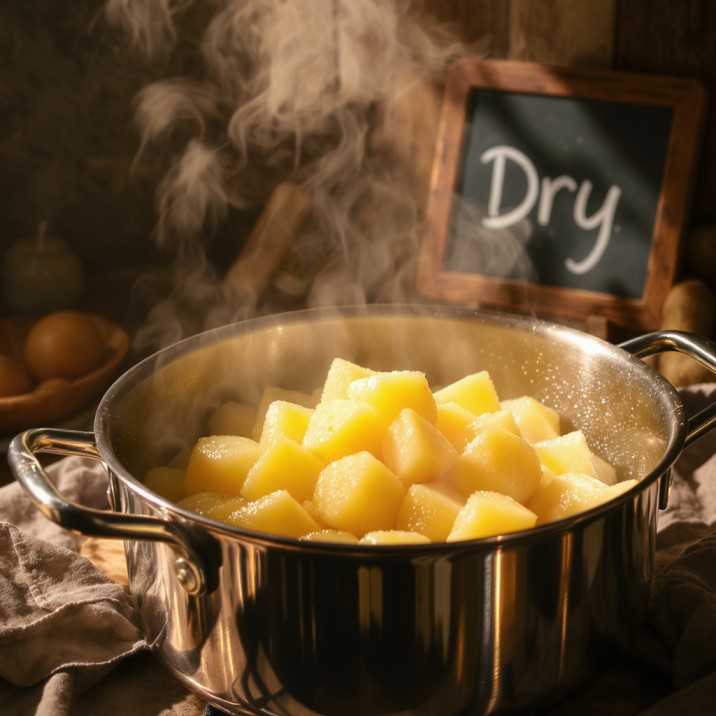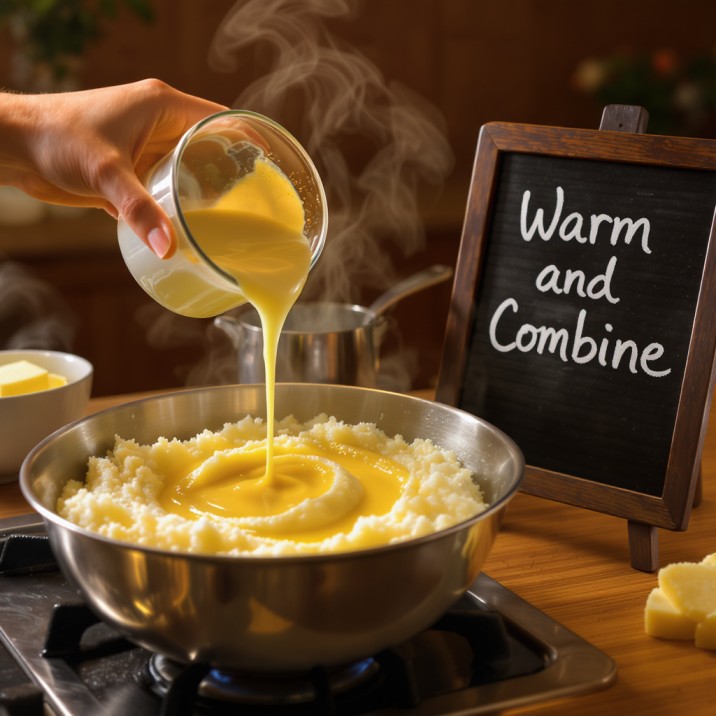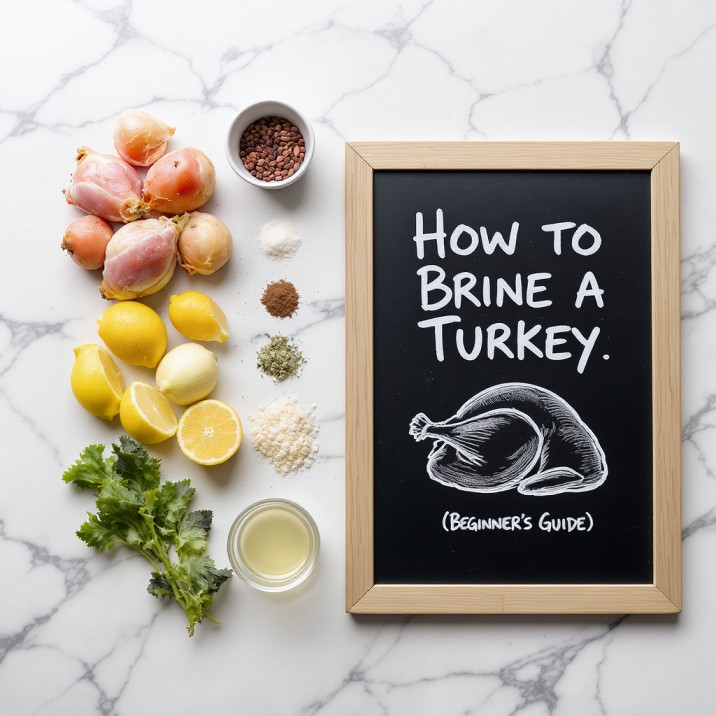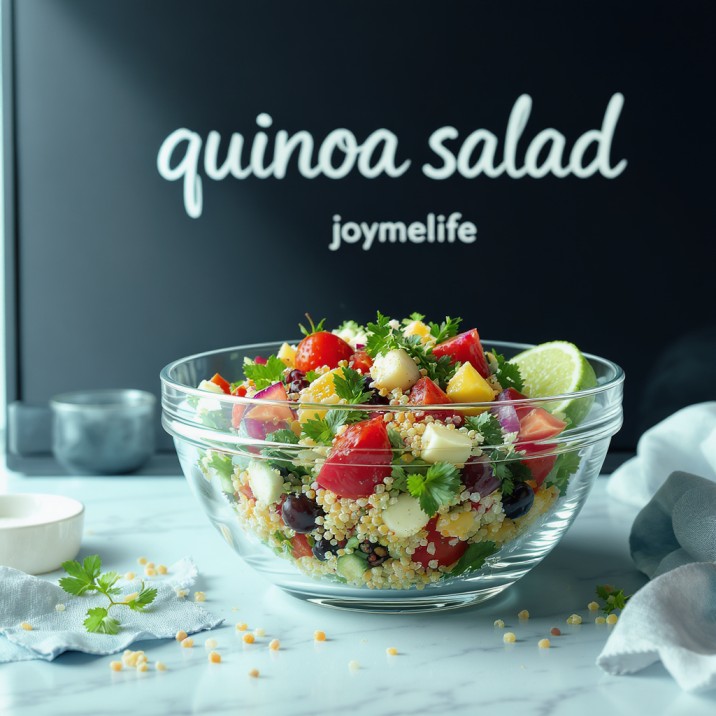
Published: 14 Nov 2025
This mashed potatoes without milk recipe isn’t a “compromise.” It’s a flavor upgrade. Whether you’re dairy-free, vegan, or just plain out of milk, this is about to become your new go-to method. Here at joymelife, we believe a pantry problem is just a chance to find a new favorite.
This easy recipe delivers incredibly creamy, fluffy, and flavorful mashed potatoes with no milk at all. The secret is using the right potatoes and a flavorful liquid/fat combination.
Why You’ll Love This “No-Milk” Mashed Potato Recipe
- Insanely Flavorful: By swapping milk (which is watery and mild) for a savory liquid like chicken or vegetable broth, you’re adding layers of flavor before you even add salt.
- Actually Creamier: We’re using science! By using the starchy potato water or a rich fat, we create a creamy emulsion without the risk of a “milky” or “watery” final product.
- Super Versatile: This base recipe is a blank canvas. It’s naturally dairy-free and can be made 100% vegan with one simple swap (vegan butter vs. olive oil).
- Fluffy, Not Gummy: This method has all the pro-tips to avoid the dreaded “potato glue,” which is the #1 fear when making mashes.
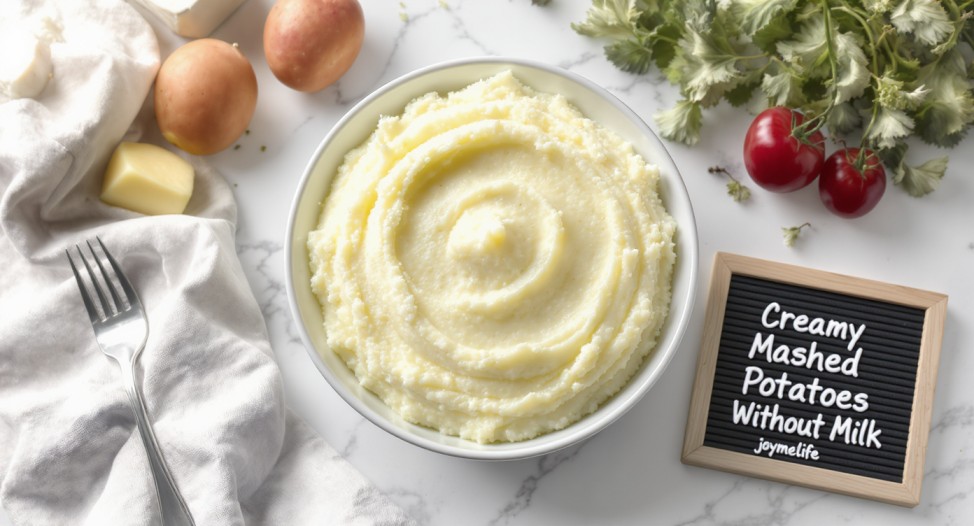
How to make really creamy mashed potatoes?
Boil

Use Yukon Gold potatoes. Peel them, cut them into uniform 1-inch chunks, and start them in a pot of cold, well-salted water. Bring to a boil and cook until they are extremely tender (a fork slides in with zero resistance).
Dry

Drain the potatoes completely, then return them to the hot, empty pot. Set the pot back on the (turned-off) hot burner for 1-2 minutes. Shake the pot to let all excess moisture steam off. This is key.
Mash

Push the hot, dry potatoes through a potato ricer (or use a hand-masher). Do this before adding any liquid.
Warm and Combine

In a separate small saucepan, gently warm your heavy cream and butter. and Add the warm cream/butter mixture to the riced potatoes and fold it in gently with a spatula. Do not overmix! Mix only until the liquid is absorbed. Season with salt.
The Real Secret to Creamy Mashes (It’s Not Milk!)
This is the most important part of the article. If you understand these three secrets, you will never make bad mashed potatoes again, with or without milk.
Secret #1: The Right Potato (Starchy vs. Waxy)
This is, without question, the most crucial choice you will make.
- Use: Starchy Potatoes (Russets, Idaho). These are low-moisture and high-starch. 1 When cooked, the starch granules swell and separate, creating a dry, fluffy, “potato-cloud” texture that’s perfect for absorbing fat and liquid. (As the Idaho Potato Commission explains, these high-starch potatoes are ideal for mashing and baking).
- Use: All-Purpose Potatoes (Yukon Golds). My personal favorite. They are the perfect “in-between.” They’re naturally more creamy and buttery-tasting than Russets but still fluffy enough to mash.
- AVOID: Waxy Potatoes (Red Potatoes, Fingerling). These are high-moisture and low-starch.2 They hold their shape when cooked (great for potato salad!), but if you try to mash them, they release their moisture and become a gummy, gluey, horrifying mess.
Secret #2: The Liquid (Choose Your Fighter)
You need a liquid, just not milk. Here are your options, from best to good:
- Starchy Potato Water (The “Free” Secret): The water you boiled your potatoes in is liquid gold. It’s full of the starch that cooked out of the potatoes. When you add it back, it re-emulsifies and creates an incredibly creamy, naturally-bound mash. (Using potato water is a pro-chef move for a reason).
- Chicken or Vegetable Broth: This is my top pick for flavor. It adds a savory, salty, umami depth that milk just can’t compete with. It makes the potatoes taste… more.
- Unsweetened Non-Dairy Milk: This is the most direct 1:1 swap. Use unsweetened, plain almond, soy, or (my favorite) oat milk. Oat milk is naturally creamier and has a neutral flavor. Warning: Do not use vanilla-flavored almond milk unless you want a… unique experience.
- Canned Coconut Milk (Full-Fat): This is for a rich, decadent, over-the-top vegan mash. It will add a very subtle coconut flavor, which is amazing if you’re pairing it with a curry or a spicy dish.
Secret #3: The Fat (This is Non-Negotiable)
Creaminess doesn’t come from milk; it comes from fat. Milk is just a vehicle. We are going to add the fat back, but in a more flavorful way.
- High-Quality Olive Oil: This is my go-to. A good, peppery olive oil adds an incredible, fruity, complex flavor. It’s the “secret ingredient” in many high-end restaurant mashed potatoes.
- Vegan Butter: (Like Miyoko’s, Melt, or Earth Balance).3 This gives you that classic, buttery flavor you expect.
- Regular Butter: If you’re not dairy-free and just out of milk, use butter. You can even brown the butter first for a nutty, next-level flavor.
Equipment Needed
- A large pot (for boiling)
- A small saucepan (for warming liquid)
- A colander
- A potato masher (a simple hand-masher, not a blender!)
- A large bowl
Step-by-Step Instructions (The Homemade Recipe)
This is the ultimate mashed potatoes without milk recipe, designed for maximum flavor and perfect texture.
Ingredients
- 2 lbs Potatoes (Russets or Yukon Golds)
- 1/2 cup Fat (High-quality Olive Oil or Vegan Butter)
- 1/2 cup Liquid (Chicken/Veggie Broth, Potato Water, or Unsweetened Oat Milk)
- 1 tsp Salt (plus more for the water)
- Black Pepper to taste
Step 1: Prep & Boil the Potatoes (The Right Way)
- Peel your potatoes (if you want, Yukon Gold skins are delicious left on) and cut them into uniform 1-inch chunks. This ensures even cooking.
- Place the potatoes in your large pot and cover them with COLD water by about 1 inch.
- Why cold water? If you drop potatoes into boiling water, the outside cooks to mush before the inside is tender. Food science experts at sites like Serious Eats have shown that starting them in cold water cooks them perfectly evenly from the inside out.
- Add a very generous pinch of salt to the water (it should taste like the sea). Bring to a boil, then reduce to a simmer and cook for 15-20 minutes, or until a fork slides in with zero resistance.
Step 2: Warm Your Liquid & Fat
- While the potatoes cook, add your 1/2 cup of liquid (broth, etc.) and your 1/2 cup of fat (olive oil/vegan butter) to your small saucepan.
- Warm them together gently on low heat.
- Why? Adding cold liquid to hot, starchy potatoes will “shock” them, causing them to seize up and turn gummy. Warm liquid absorbs beautifully, keeping them fluffy.
Step 3: Drain & Dry the Potatoes
- Drain the potatoes in a colander. (If you’re using potato water, reserve 1 cup of it before you drain!)
- Return the drained potatoes to the hot, empty pot. Place it back on the (turned-off) hot burner for 1-2 minutes.
- Shake the pot gently. This steams off all remaining moisture. This is the secret to fluffy, not-soggy potatoes.
Step 4: Mash, Don’t Whip!
- Turn off the heat. Use your hand masher to mash the dry potatoes. Get all the big lumps.
- Why not a blender? A blender, food processor, or immersion blender will overwork the potato starches, turning them into a sticky, gluey paste. A hand masher gently breaks them.
Step 5: Add the Fat First, Then the Liquid
- Pour your warm fat/liquid mixture over the mashed potatoes.
- Science tip: Add the fat first if you’ve kept them separate. The fat coats the starch molecules, protecting them from breaking down.
- Use your masher or a spatula to gently fold and mash everything together until just combined. Do not overmix!
- Taste for seasoning. Add your 1 tsp of salt (or more), and plenty of black pepper.
Expert Tips and Tricks for Fluffy Potatoes
This is the cheat sheet for perfection.
- Use the Right Potato: Russets or Yukon Golds. Period.
- Start in Cold, Salty Water: For even cooking and flavor from the inside out.
- Dry Your Potatoes: After draining, let them steam dry in the hot pot. Moisture is the enemy of fluffy.
- Warm Your Liquids: Never add cold liquids to hot potatoes.
- NEVER Use a Blender: A hand masher or a ricer (for the ultimate texture) is all you need. Overmixing = glue.
- Fat First: Add your fat (oil/vegan butter) before your liquid to coat the starches.
Tips for Success: A Quick-Hit List
- Do: Use Russet or Yukon Gold potatoes.
- Do: Salt your boiling water generously.
- Do: Drain and dry the potatoes completely.
- Do: Warm your broth/oil before adding.
- Don’t: Use waxy red potatoes.
- Don’t: Use a blender or food processor.
- Don’t: Add cold liquids.
Recipe Variations and Possible Substitutions
Vegan Roasted Garlic Mashed Potatoes (The GOAT)
This is, in my opinion, the most flavorful version.
- Slice the top off a whole head of garlic. Drizzle with olive oil, wrap in foil, and roast at 400°F (200°C) for 40-45 minutes until soft and caramelized.
- Squeeze the roasted garlic “paste” into the potatoes when you mash them in Step 4.
- Use olive oil as your fat and vegetable broth as your liquid. It’s spectacular.
“I’m Just Out of Milk” (Not Dairy-Free) Version
If you’re not vegan and just in a pinch, you have more options.
- Fat: Use regular butter (browned butter is even better).
- Liquid: Use chicken broth.
- Creaminess: Add a big dollop of sour cream, Greek yogurt, or even mayonnaise (it’s just eggs and oil!) or cream cheese at the end. This adds both fat and a wonderful tangy flavor.
Ultra-Rich “Coconut Cream” Version
- Use full-fat canned coconut milk (just the solid cream part if you can) as your liquid and fat, all in one.
- Add a big pinch of chives or scallions to cut the richness. This is amazing with spicy food.
Serving and Pairing Suggestions
These mashed potatoes are a robust, flavorful side dish.
- Serving Suggestions:
- Serve in a warm bowl, make a “well” in the center.
- Add a large pat of vegan butter or a big drizzle of high-quality olive oil on top (a “finishing” oil).
- Garnish with fresh chives, parsley, or cracked black pepper.
- Pairing:
- The perfect base for a rich gravy (like a mushroom gravy).
- Alongside roasted chicken, seared steak, or a hearty lentil shepherd’s pie.
- With sausages (“bangers and mash”).
Storage and Reheating Tips (A Common Problem!)
Mashed potatoes are notorious for reheating badly. They get dry and taste like… sadness.
- Storage: Store in an airtight container in the fridge for up to 4 days.
- Reheating (The Right Way):
- Stovetop (Best): Put the cold, thick mashed potatoes in a pot over low heat. Add a splash of your liquid (broth or non-dairy milk) and a pat of your fat (vegan butter/oil). Stir gently until warmed through. You’re essentially “refreshing” them.
- Microwave (Okay): Place in a microwave-safe bowl. Add a splash of liquid. Cover and microwave in 1-minute bursts, stirring in between, until hot.

Recipe FAQs (Common Questions About This Recipe)
Q: Why are my mashed potatoes gluey/gummy?
A: You either used the wrong potato (waxy) or you over-mixed them (with a blender/food processor). The starch cells ruptured and released “potato glue.”
Q: What’s the best non-dairy milk to use?
A: Unsweetened Oat Milk. It’s the creamiest and most neutral-flavored. Unsweetened soy and almond milk also work, but make sure they are not vanilla-flavored.
Q: Can I leave the skins on?
A: Yes! I love skin-on mashed potatoes, especially with Yukon Golds. Their skin is thin and adds great texture and nutrients. Russet skins can be a bit tough, so I’d peel those.
Q: Can I use an immersion blender for just a second?
A: Please don’t! Even “just a second” is enough to start the glue-making process. A simple $5 hand masher is your best friend.
What is a good substitute for cream in mashed potatoes?
You need to replace the high fat and liquid content of cream. Here are your best options:
Dairy-Based Substitutes:
Cream Cheese: This is a fantastic substitute. It adds richness and a wonderful, slight tang.
Sour Cream: Also excellent. It makes the mash rich and tangy.
Full-Fat Greek Yogurt: A good option for a tangy, slightly lighter (but still creamy) result.
Dairy-Free / Vegan Substitutes:
Full-Fat Canned Coconut Milk: Use the solid “cream” part from the top of the can. This is the richest, creamiest vegan option.
Unsweetened Oat Milk: This is the best non-dairy milk, as it’s naturally creamier and has a neutral flavor.
Starchy Potato Water: The water you boiled the potatoes in! Reserve a cup before you drain. It’s full of starch and helps create a creamy, natural emulsion.
Conclusion: You Never Needed the Milk Anyway
See? That empty milk carton was a blessing in disguise. You’ve just made a batch of incredibly creamy, fluffy, and deeply flavorful mashed potatoes that are better than any milk-based version. This method—focusing on the right potato, drying the starches, and using a flavorful fat/liquid combo—is a technique you’ll use forever.
Now it’s your turn!
If you make this recipe, please leave a comment below! What’s your favorite variation? Did you try the roasted garlic? We at Joymelife would love to hear about your experience.
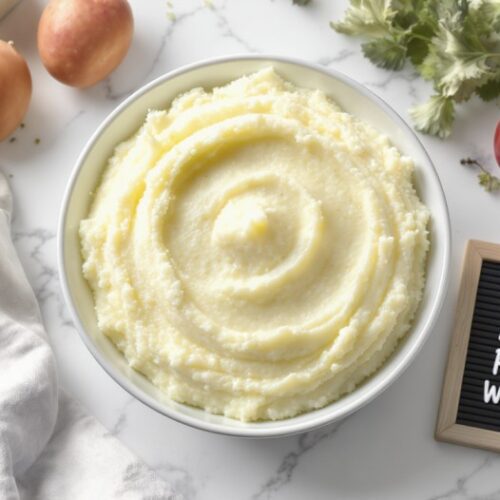
Creamy Mashed Potatoes Without Milk
Equipment
- A large pot (for boiling)
- A small saucepan (for warming liquid)
- A colander
- A potato masher (a simple hand-masher, not a blender!)
- A large bowl
Ingredients
- 2 lbs Potatoes Russets or Yukon Golds, peeled and cubed5
- 1/2 cup Fat High-Quality Olive Oil, Vegan Butter, or Regular Butter
- 1/2 cup Liquid WARMED (Chicken/Vegetable Broth, Unsweetened Oat Milk, or Starchy Potato Water)
- 1 tsp Salt plus more for boiling water
- 1/2 tsp Black Pepper
Instructions
- Prep & Boil: Place the cubed potatoes in a large pot. Cover with cold water by 1 inch. Add a large pinch of salt. Bring to a boil, then reduce to a simmer and cook for 15-20 minutes, or until fork-tender.
- Warm Liquid: While potatoes cook, gently warm your 1/2 cup of liquid (broth) and 1/2 cup of fat (olive oil) in a small saucepan. Set aside.
- Drain & Dry: Reserve 1 cup of the starchy potato water (if using) before draining. Drain the potatoes in a colander, then return them to the hot, empty pot. Let them sit on the warm (off) burner for 1-2 minutes to steam dry.
- Mash: Use a hand masher to mash the dry potatoes until all large lumps are gone.
- Combine: Add the warm liquid/fat mixture to the potatoes. Gently fold and mash until just combined. (Do not overmix!)
- Season: Stir in the 1 tsp of salt and 1/2 tsp of black pepper. Taste and add more seasoning as needed. Serve immediately.
Notes




